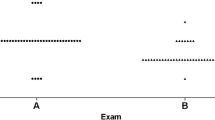Abstract
Introduction
The purpose of this experimental phantom study was to compare radiation doses imparted to patients undergoing classical two-plane digital subtraction angiography (2-plane DSA) and 3D rotational angiography in interventional neuroradiology.
Methods
Thermoluminescence dosimeter (TLD) measurements were performed at an anthropomorphic phantom using a digital interventional angiography system. Two-plane DSA included posterior/anterior (PA) and lateral (LAT) projections (frame-rate, 7.6 frames (PA) and 9.8 frames (LAT) for a scan time of approximately 8 s; image intensifier 27 cm (PA) and 25 cm (LAT)). For 3D rotational angiography, 122 images were acquired from one single image run with the imaging system rotating 240° around the phantom’s head (image intensifier 37 cm).
Results
Effective dose was 0.4 mSv for 2-plane DSA compared to 0.1 mSv for 3D rotational angiography. Organ doses were approximately two to five times higher for classical 2-plane technique compared to the 3D rotational angiography, respectively: brain (11.4 vs. 2.4 mSv), eye lens (4.5 vs.1 mSv), salivary glands (7 vs. 1,7 mSv), oral mucosa (2.7 vs.0.9 mSv), thyroid (0.5 vs. 0.2 mSv), thymus (0.2 vs. 0.05 mSv), bone marrow within imaged region (1 vs. 0.2 mSv), oesophagus (0.07 vs. 0.03 mSv), endotracheal system (2.6 vs. 0.7 mSv) and skeletal components in the imaged region (0.7 vs. 0.2 mSv).
Conclusion
Three-dimensional rotational angiography clearly reduces radiation doses compared to the classical 2-plane technique. Replacement of additional 2-plane DSA projections with 3D rotational angiography will lead to a remarkable decrease in patient radiation dose, without loss of image quality. Thus, we recommend routine application of 3D rotational angiography, in particular for diagnostic assessment of aneurysm morphology.

Similar content being viewed by others
References
Ringelstein A, Mueller O, Mönninghoff C, Hahnemann ML, Sure U, Forsting M, Schlamann M (2014) 3D rotational angiography after non-traumatic SAH. Röfo 186(7):675–679
Abe T, Hirohata M, Tanaka N et al (2002) Clinical benefits of rotational 3D angiography in endovascular treatment of ruptured cerebral aneurysms. AJNR 23:686–688
Hirai T, Korogi Y, Suginohara K et al (2003) Clinical usefulness of unsubtracted 3D digital angiography compared with rotational digital angiography in the pretreatment evaluation of intracranial aneurysms. AJNR 24:1067–1074
Alexander MD, Oliff MC, Olorunsola OG et al (2010) Patient radiation exposure during diagnostic and therapeutic interventional neuroradiology procedures. J Neurointerv Surg 2:6–10
Marshall NW, Noble J, Faulkner K (1995) Patient and staff dosimetry in neuroradiological procedures. Br J Radiol 68:495–501
Gosch D, Kurze W, Deckert F, Schulz T, Patz A, Kahn T (2006) Radiation exposure with 3D DSA of the skull. Röfo 178(9):880–885
Bridcut RR, Murphy E, Workman A et al (2007) Patient dose from 3D rotational neurovascular studies. Br J Radiol 80:362–366
Struffert T, Hauer M, Banckwitz R, Köhler C, Royalty K, Doerfler A (2014) Effective dose to patient measurements in flat-detector and multislice computed tomography: a comparison of applications in neuroradiology. Eur Radiol 24(6):1257–1265
Lechel U, Becker C, Langenfeld-Jäger G, Brix G (2009) Dose reduction by automatic exposure control in multi-slice computed tomography − comparison between measurement and calculation. Eur Radiology 19:1027–1034
ICRP Publication 103 (2007) Recommendations of the international commission on radiological protection. Annals ICRP Elsevier Sci, Oxford 37:2–4
Cristy M, Eckerman KF (1987) Specific absorbed fractions of energy at various ages from internal photon sources. I. Methods. Oak Ridge National Laboratory, Oak Ridge, Tennessee; Report ORNL/TM-8381/V1
Conference of Radiation Control Program Directors, Inc (CRCPD) 205 Capital Avenue Frankfort, KY 40601; Reviewed/Republished: September 2008 www.crcpd.org
Kiyosue H, Tanoue S, Okahara M et al (2002) Anatomic features predictive of complete aneurysm occlusion can be determined with three-dimensional digital subtraction angiography. AJNR 23:1206–1213
Anxionnat R, Bracard S, Ducrocq X et al (2001) Intracranial aneurysms: clinical value of 3D digital subtraction angiography in the therapeutic decision and endovascular treatment. Radiology 218:799–808
Sugahara T, Korogi Y, Nakashima K et al (2002) Comparison of 2D and 3D digital subtraction angiography in evaluation of intracranial aneurysms. AJNR 23:1545–1552
Van Rooij WJ, Sprengers ME, De Gast AN et al (2008) 3D rotational angiography: the new gold standard in the detection of additional intracranial aneurysms. AJNR 29:976–979
Lescher S, Samaana T, Berkefeld J (2014) Evaluation of the pontine perforators of the basilar artery using digital subtraction angiography in high resolution and 3D rotation technique. AJNR 35(10):1942–1947
Van Rooij WJ, Pelusoa JPP, Sluzewskia M, Beute GN (2008) Additional value of 3D rotational angiography in angiographically negative aneurysmal subarachnoid hemorrhage: how negative is negative? AJNR 29:962–966
Ishihara H, Kato S, Akimura T et al (2007) Angiogram-negative subarachnoid hemorrhage in the era of three dimensional rotational angiography. J Clin Neurosci 14:252–255
Brinjikji W, Cloft H, Lanzino G, Kallmes DF (2009) Comparison of 2D digital subtraction angiography and 3D rotational angiography in the evaluation of dome-to-neck ratio. AJNR 30:831–834
Author information
Authors and Affiliations
Corresponding author
Ethics declarations
We declare that this manuscript does not contain clinical studies or patient data.
Conflict of interest
We declare that we have no conflict of interest.
Rights and permissions
About this article
Cite this article
Guberina, N., Lechel, U., Forsting, M. et al. Dose comparison of classical 2-plane DSA and 3D rotational angiography for the assessment of intracranial aneurysms. Neuroradiology 58, 673–678 (2016). https://doi.org/10.1007/s00234-016-1671-4
Received:
Accepted:
Published:
Issue Date:
DOI: https://doi.org/10.1007/s00234-016-1671-4




